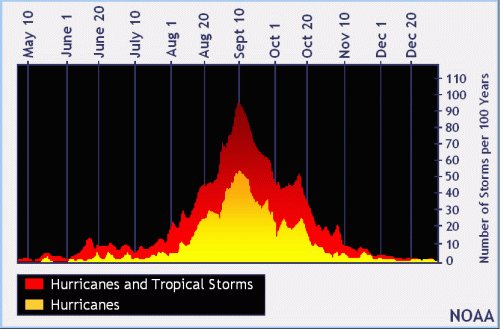Hurricane FAQs
17 October 2021
1. What is a hurricane?
A hurricane is a type of tropical cyclone, which is a low-pressure system that forms in the tropics and is accompanied by high winds and rain.
2. What causes a hurricane?
The ingredients for a hurricane are:
- warm ocean waters
- high light winds
- rotation or spin
If these conditions exist for long enough, they combine to produce the violent winds, voracious waves, and torrential rain we’ve come to associate with a hurricane.
3. What is a tropical storm or hurricane watch?
A tropical storm or hurricane watch indicates a storm is approximately 48 hours away from landfall. All hurricanes start out as tropical storms. Once a storm is named, you cannot purchase travel insurance protection for that storm.
4. What is a tropical storm or hurricane warning?
A tropical storm or hurricane warning indicates a life-threatening situation and a hurricane that is less than 24 hours away from landfall.
5. What is a storm surge?
Storm surge is a term for the large dome of water that accompanies the landfall of a hurricane. Storm surges are responsible for approximately 90% of all deaths that occur in hurricanes.
6. How many storms have occurred in the last 100 years?
(Source: https://hurricanes.noaa.gov/prepare/season.htm)
7. How many storms occur each season?
On average, the following number of storms occur each season:
- Between 9 and 10 named tropical storms,
- Between 5 and 6 named hurricanes.
- Between 2 and 3 major (category 3-5) hurricanes
8. How are hurricanes classified?
Once a hurricane develops, it is classified with the Saffir-Simpson scale by measuring its sustained wind speed and barometric pressure.
| Category | Wind Speed | Barometric Pressure |
| 1 | 74-95 mph | at least 28.94 in. of Hg |
| 2 | 96-110 mph | 28.50-28.91 in. of Hg |
| 3 | 110-130 mph | 27.91-28.47 in. of Hg |
| 4 | 131-155 mph | 27.17-27.88 ian. of Hg |
| 5 | 155+ mph | greater than 27.27 in. of Hg |
9. Which hurricanes cause the most damage?
While a Category 1 hurricane typically causes minimal damage and a Category 5 hurricane often causes catastrophic damage, these are relative terms because lower category storms sometimes inflict greater damage than higher category storms depending on where they strike and what hazards they carry along with them.
10. How are hurricanes named?
For several hundred years, hurricanes were named after the particular saint’s day on which they occurred. As an example, Hurricane San Felipe struck Puerto Rico on September 13th in 1876. When another hurricane struck Puerto Rico on the same day in 1928, it was named Hurricane San Felipe the second and it became clear that a better naming scheme was required.
In 1951, the U.S. adopted a plan of naming storms using the alphabet, starting with the first letter (A) each year. The practice of using exclusively female names, which began during World War II after a woman’s name was used for a storm in the 1940s novel called Storm by George R. Stewart, ended in 1978. Hurricanes are now named according to an agreed-upon rotation of six lists of names, which are generated by the World Meteorological Organization.
11. Are hurricane names ever retired?
When a particularly destructive hurricane occurs, that name is often retired off the list. One example of this is Hurricane Hugo in 1989, which devastated many small islands east of Puerto Rico. Hugo then skimmed over Puerto Rico and slammed into South Carolina. When Hugo was over, 82 people were dead and the name was retired from the list. It was replaced by Humberto.
Related topics
Damian Tysdal is the founder of CoverTrip, and is a licensed agent for travel insurance (MA 1883287). He believes travel insurance should be easier to understand, and started the first travel insurance blog in 2006.

